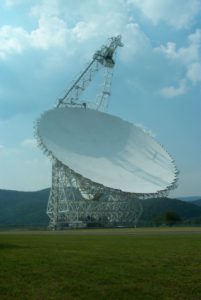
Breakthrough Listen – the initiative to find signs of intelligent life in the universe – has released its 11 events ranked highest for significance as well as summary data analysis results. It is considered unlikely that any of these signals originate from artificial extraterrestrial sources, but the search continues. Further, Listen has submitted for publication (available April 20) in a leading astrophysics journal the analysis of 692 stars, comprising all spectral types, observed during its first year of observations with the Green Bank Telescope.
Breakthrough Listen has so far acquired several petabytes of data using the Green Bank Radio Telescope (GBT) in West Virginia, Lick Observatory’s Automated Planet Finder on Mt. Hamilton in California, and the Parkes Radio Telescope in Australia. The Breakthrough Listen science team at the University of California, Berkeley’s SETI Research Center (BSRC) designed and built an analysis pipeline that scans through billions of radio channels in a search for unique signals that might indicate the presence of technology developed by civilizations outside our Solar System.
Initial results from deploying this pipeline on the first year of Breakthrough Listen data taken with the “L-band” receiver at GBT (covering frequencies from 1.1 – 1.9 GHz) have been submitted for publication in one of the world’s leading astronomy journals. Snapshot data has been released for the 11 highest ranked events that rose above the pipeline’s threshold for significance, as well as summary results from the complete analysis. Data is available atwww.breakthroughinitiatives.org/OpenDataSearch, and BSRC Director Andrew Siemion will be on Facebook Live presenting the results at 3:10pm PT this Thursday, April 20 at the Breakthrough Discuss conference.
“With the submission of this paper, the first scientific results from Breakthrough Listen are now available for the world to review,” said Dr. Siemion. “Although the search has not yet detected a convincing signal from extraterrestrial intelligence, these are early days. The work that has been completed so far provides a launch pad for deeper and more comprehensive analysis to come.”
The software used for the analysis in these papers has been made available in a github repository[1], along with associated documentation[2]. This enables programmers and machine learning experts (even those with no prior astronomy knowledge) to join the search for artificial signals, by developing increasingly sophisticated algorithms to comb through the datasets that continue to flow not just from GBT, but from the other participating telescopes.
Data Analysis
The basics of searching for signatures of extraterrestrial technology[3] are quite simple. Artificial signals can be distinguished from natural processes through features like narrow bandwidth; irregular spectral behaviour, pulsing, or modulation patterns; as well as broad-band signals with unusual characteristics. However, human technology emits signals (known as radio frequency interference) similar to the ones being searched for. This means that algorithms must be designed to ensure that signals are coming from a fixed point relative to the stars or other targets being observed, and not from local interferers (including Earth-orbiting satellites).
The Berkeley SETI Research Center Breakthrough Listen science team examined data on 692 stars from the primary target list from GBT, consisting of three five-minute observations per star, interspersed with five-minute observations of a set of secondary targets. By performing an analysis of thresholded frequency channels, as well as a Doppler drift search (for details see:
https://github.com/UCBerkeleySETI/breakthrough/blob/master/GBT/README.md) the pipeline identified channels where radio emission was seen for each target (referred to as “hits”). The pipeline produced millions of hits for the sample as a whole, of which the vast majority are almost certainly radio frequency interference from human technology. Eleven events rose above the pipeline threshold for significance, but further detailed analysis indicates that it is unlikely that any of these signals originate from artificial extraterrestrial sources.
For each star sample, the team searched through the entire database of events, looking for radio channels where events occurred only at one or a small handful of positions on the sky. While these stars have unique radio “fingerprints”, this is by no means convincing evidence that they host planets inhabited by extraterrestrial civilizations. However, the search for signals that are localized on the sky and appear unusual in some way provides an excellent way to select promising targets for follow-up observations.
The BSRC team continues to develop more and more sophisticated algorithms, and plans to release updated analyses of Listen data approximately once every six months. The Berkeley team also seeks continued and expanded engagement with signal processing and machine learning experts to help mine the Breakthrough Listen dataset in the search for evidence of signals from extraterrestrial civilizations.
Project Leadership
- Martin Rees, Astronomer Royal, Fellow of Trinity College; Emeritus Professor of Cosmology and Astrophysics, University of Cambridge.
- Pete Worden, Chairman, Breakthrough Prize Foundation.
- Frank Drake, Chairman Emeritus, SETI Institute; Professor Emeritus of Astronomy and Astrophysics, University of California, Santa Cruz; Founding Director, National Astronomy and Ionosphere Center; Former Goldwin Smith Professor of Astronomy, Cornell University.
- Ann Druyan, Creative Director of the Interstellar Message, NASA Voyager; Co-Founder and CEO, Cosmos Studios; Emmy and Peabody award winning Writer and Producer.
- Dan Werthimer, Co-founder and chief scientist of the SETI@home project; director of SERENDIP; principal investigator for CASPER.
- Andrew Siemion, Director, Berkeley SETI Research Center.
[1] https://github.com/UCBerkeleySETI/turbo_seti
[2] https://github.com/UCBerkeleySETI/breakthrough/blob/master/GBT/README.md
[3] As described by the Berkeley SETI Research Center team at http://seti.berkeley.edu/listen
Original published at: http://www.spacewatchme.com/2017/04/breakthrough-listen-initiative-publishes-initial-results
 SpaceWatch.Global An independent perspective on space
SpaceWatch.Global An independent perspective on space

